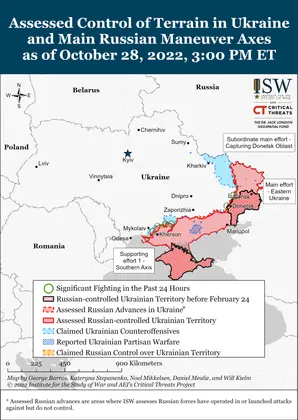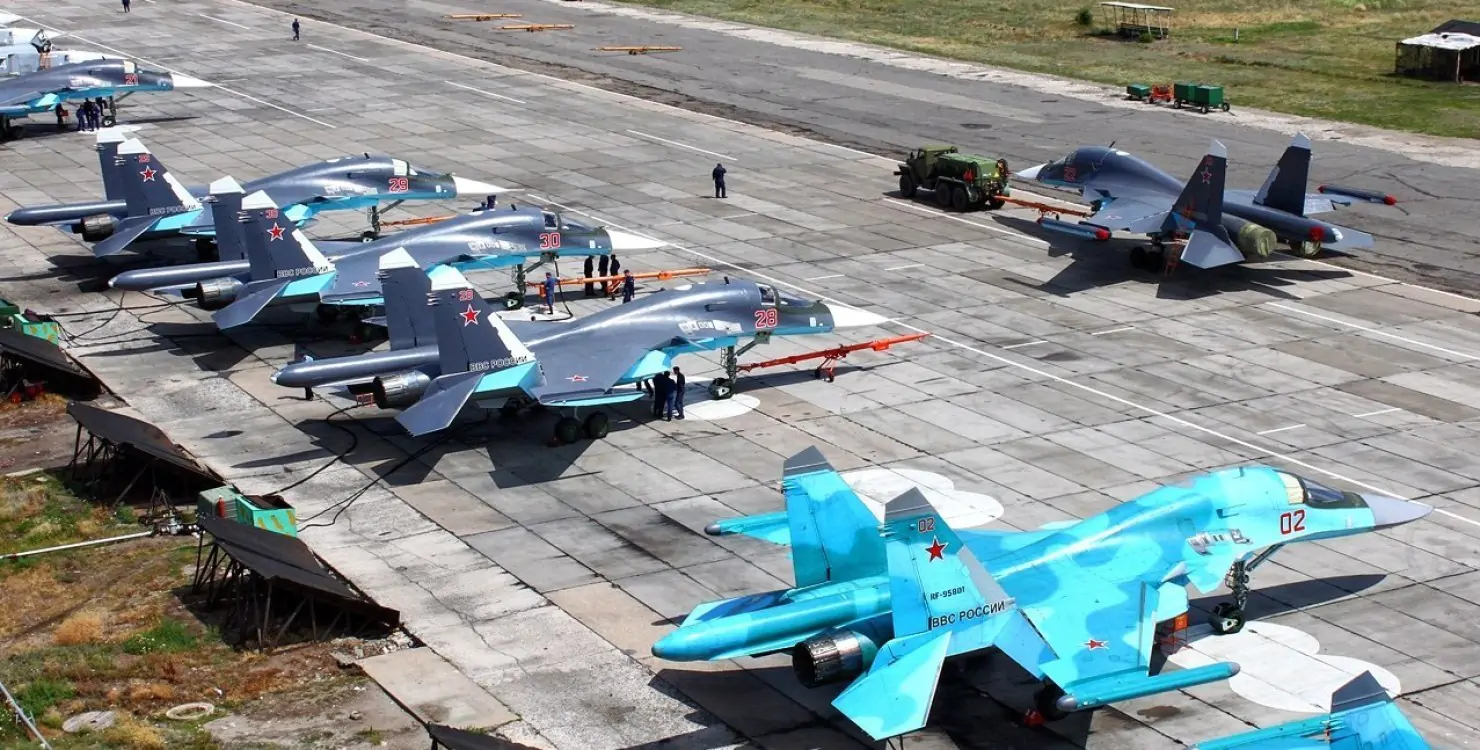Key Takeaways
- Russian forces are not making significant progress around Bakhmut, Donetsk Oblast or anywhere else along the front lines.
- President Vladimir Putin and Defense Minister Sergei Shoigu announced the end of partial mobilization.
- Putin may be attempting to rehabilitate Shoigu’s image in the information space to counter the growing influence of the pro-war siloviki faction.
- The growing influence of the siloviki faction is continuing to fracture the Russian pro-war community.
- Russian sources claimed that Ukrainian forces conducted counteroffensive operations in the direction of Kreminna and Svatove.
- Russian forces continued to deploy mobilized personnel to and establish defensive positions on the west bank of the Dnipro River in Kherson Oblast.
- Russian sources claimed that Ukrainian forces conducted counteroffensive operations in northwestern Kherson Oblast.
- Russian forces continued ground attacks in Donetsk Oblast.
- Russian occupation authorities completed their “evacuation” of parts of occupied Kherson Oblast.
- Russian occupation authorities reportedly plan to force Russian citizenship on Ukrainian civilians in occupied parts of Ukraine by October 30, likely in part to legalize the forced mobilization of Ukrainian civilians as part of the November 1 autumn conscription cycle.
- Russian occupation authorities are continuing their attempts to erase Ukrainian history, culture, and national identity in Russian-occupied parts of Ukraine.
Russian forces are not making significant progress around Bakhmut, Donetsk Oblast or anywhere else along the front lines. A Russian information operation is advancing the narrative that Russian forces are making significant progress in Bakhmut, likely to improve morale among Russian forces and possibly to improve the personal standing of Wagner Group financier Yevgeny Prigozhin, whose forces are largely responsible for the minimal gains in the area. Russian forces have made limited advances towards the Ukrainian strongpoint in Bakhmut but at a very slow speed and at great cost. Prigozhin acknowledged the slow pace of Wagner Group ground operations around Bakhmut on October 23 and stated that Wagner forces advance only 100-200m per day, which he absurdly claimed was a normal rate for modern advances.[1] Ukrainian forces recaptured a concrete factory on the eastern outskirts of Bakhmut around October 24.[2] Ukrainian military officials stated on October 16 that Russian forces had falsely claimed to have captured several towns near Bakhmut within the past several days, but Ukrainian forces held their lines against those Russian attacks.[3] Russian forces are likely falsifying claims of advances in the Bakhmut area to portray themselves as making gains in at least one sector amid continuing losses in northeast and southern Ukraine. Even the claimed rate of advance would be failure for a main effort in mechanized war–and the claims are, in fact, exaggerated.

Ukrainian HIMARS Attack Blasts Russian Mobile HQ
JOIN US ON TELEGRAM
Follow our coverage of the war on the @Kyivpost_official.
Russian President Vladimir Putin and Russian Defense Minister Sergei Shoigu declared the end of Russian military mobilization on October 28. Shoigu stated that military commissariats will recruit only volunteers and contract soldiers moving forward.[4] Shoigu stated that Russia mobilized 300,000 men, 82,000 of whom are deployed in Ukraine and 218,000 of whom are training at Russian training grounds.[5] Putin stated that 41,000 of the 82,000 servicemen in Ukraine are serving in combat units.[6] Putin acknowledged that Russian forces experienced logistical and supply issues with mobilized forces but falsely asserted that these problems affected only the ”initial stage” of mobilization and that these problems are now solved.[7] Putin stated Russia must ”draw necessary conclusions,” modernize ”the entire system of military registration and enlistment offices” and ”think over and make adjustments to the structure of all components of the Armed Forces, including the Ground Forces.”[8]
Putin likely ended mobilization in Russia to free up administrative and training capacity in time for the delayed start of the Russian autumn conscription cycle, which will begin on November 1.[9] Russia’s military likely does not have the capacity to simultaneously support training 218,000 mobilized men and approximately 120,000 new autumn conscripts.[10] It is unclear how autumn 2022 conscripts will complete their training, moreover, since the usual capstones for Russian conscripts‘ training involves joining a Russian military unit—which are already fighting in Ukraine and badly damaged.
Russia‘s now-completed mobilization is unlikely to decisively impact Russian combat power. Putin described a 50-50 split between mobilized personnel in combat and support roles in Ukraine. If that ratio applies generally, it suggests that a total of 150,000 mobilized personnel will deploy to combat roles in Ukraine after training is complete, likely sometime in November. Russia’s deployment of 41,000 poorly trained combat personnel to Ukraine may have temporarily stiffened Russian defensive lines, although these reservists have not yet faced the full weight of a major and prepared Ukrainian counteroffensive thrust. The deployment has not significantly increased Russian combat power. The deployment of an additional 110,000 or so mobilized men to combat units therefore remains unlikely to change the trajectory of the war.
Putin may be attempting to reestablish Defense Minister Sergei Shoigu’s authority in the Russian information space to balance the growing influence of the Russian pro-war siloviki faction. The Russian siloviki faction refers to people with meaningful power bases within Putin’s inner circle who are fielding combat forces in Ukraine. Putin could have announced the end of mobilization himself instead of in a meeting with Shoigu or could have tasked Shoigu with concluding the flawed mobilization effort on his own. Their staged public meeting is consistent with the recent surge in Shoigu’s media appearances. For example, Shoigu held several publicized calls with his Turkish, Chinese, and Western counterparts between October 23 and 26.[11] These high-profile meetings differentiate Shoigu and the Russian higher military command from the siloviki, who do not hold the same rank or authority despite their popularity in the Russian information space. Shoigu had made very limited public appearances over the spring and summer.[12] Shoigu’s presence in the information space depends on the approval of the Kremlin, since Putin can control when and whether Shoigu speaks publicly. Shoigu’s siloviki rivals control their own Telegram channels and speak freely to the media.
The growing influence of the siloviki faction – led by Wagner Group financier Yevgeniy Prigozhin – is further fracturing the Russian pro-war community. Chechen leader Ramzan Kadyrov for the second time criticized the commander of the Central Military District (CMD), Colonel General Alexander Lapin, for his management of the Svatove-Kreminna line on October 27.[13] Kadyrov contrasted his harsh criticisms of Lapin with high praise for Prigozhin and Wagner units, even calling Prigozhin a ”born warrior.” Kadyrov has resumed his criticisms of the progress of the Russian invasion and Russian higher military command since October 25, likely in response to a Ukrainian strike on Chechen units in northeastern Kherson Oblast.[14] Kadyrov has since announced that the Ukrainian strike killed 23 Chechen fighters and wounded 58 troops.[15]
Kadyrov accused Lapin of failing to communicate with Chechen leaders, claiming that he had unsuccessfully attempted to reach Lapin to discuss Ukrainian breakthroughs around Lyman. Kadyrov added that no one could locate Lapin or his subordinates when one of Lapin’s units redeployed from Rubizhne to reinforce the frontlines.[16] Kadyrov claimed that Chechen units had to hold Russian defensive positions without Lapin’s support, stated that soldiers are increasingly deserting from Lapin’s units, and insinuated that Lapin will soon lose Svatove.[17] Kadyrov previously attacked Lapin on October 1 for moving his headquarters far from the frontlines and for his military failures, and Prigozhin publicly agreed with Kadyrov’s statement at that time.[18] Kadyrov’s praise of Prigozhin further demonstrates that siloviki are increasingly promoting their parallel military structures at the expense of the reputation of the Russian Armed Forces.
Kadyrov’s accusations have once again created a rift among pro-war Russian milbloggers and exposed concerns over the growing influence of the siloviki faction within the pro-war community. Some milbloggers expressed their support for Lapin, noting that his failures – such as large losses of military equipment in Chernihiv Oblast or the devastating failure at the Siverskyi Donets river crossing in Bilohorivka – were not as severe as other failures of some Russian military commanders even though these same milbloggers had indirectly criticized Lapin for these incidents.[19] Most pro-Lapin milbloggers blamed the Russian Ministry of Defense (MoD) for abstaining from publicly defending Lapin against the likes of Kadyrov and Prigozhin. A milblogger even noted that it is unacceptable for any Russian governor or regional head to criticize the Russian Armed Forces as such critiques can lead ”to the direct road to the erosion of the very essence of the Russian state.”[20] Kadyrov’s only formal position is head of the Chechen Republic. The milblogger noted that Russian commanders cannot defend their actions on Telegram – unlike Prigozhin and Kadyrov – and stated that such critiques only ignite internal conflicts. Wagner-affiliated Telegram channels, by contrast, amplified reports of dire conditions on the Svatove-Kreminna frontline, discussing the high number of deserters, low morale, poor living conditions, and command cowardice.[21]
Kadyrov’s second critique of Lapin indicates a further fragmentation within the pro-war community that may allow Priogozhin to accrue more power in the long-term. Putin will need to continue to appease the siloviki faction while attempting to support his disgraced higher military command and retain favor with the milbloggers that respect some conventional Russian military commanders such as Lapin and the Commander of Russian forces in Ukraine, Sergei Surovikin.
See the full report here.
You can also highlight the text and press Ctrl + Enter






